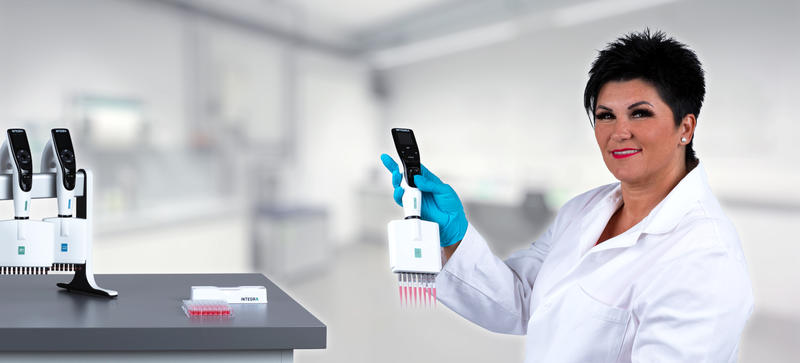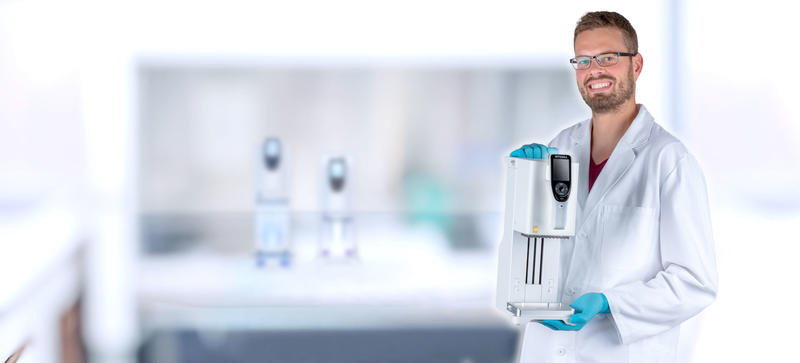-
3 simple and proven automation protocols for serial dilution on the ASSIST PLUS pipetting robot
Serial dilution made easy
Serial dilution, a reduction in concentration by constant dilution factor, is a common approach for screening related applications, such as the determination of minimum inhibitory concentrations (MIC) in drug discovery, the most probable numbers (MPN) in microbiology or general nucleic acid quantifications in molecular biology. Despite being a simple technique, poor liquid handling of interdependent dilution steps can cause error propagation and accumulation. Thorough mixing, therefore, is crucial but puts a lot of strain on the thumb, which increases the risk of repetitive strain injuries. Furthermore, when done regularly, serial dilutions are significantly time-consuming procedures.
Here we show the simplest way of how to do serial dilutions with the VOYAGER adjustable tip spacing pipette on the ASSIST PLUS pipetting robot to gain more walk-away time. The provided protocols detail optimal settings with reliable results when diluting analytes into water. In our comprehensive guide you can learn even more about key parameters when facing different conditions.
-
Table of contents
Serial dilution, a reduction in concentration by constant dilution factor, is a common approach for screening related applications, such as the determination of minimum inhibitory concentrations (MIC) in drug discovery, the most probable numbers (MPN) in microbiology or general nucleic acid quantifications in molecular biology. Despite being a simple technique, poor liquid handling of interdependent dilution steps can cause error propagation and accumulation. Thorough mixing, therefore, is crucial but puts a lot of strain on the thumb, which increases the risk of repetitive strain injuries. Furthermore, when done regularly, serial dilutions are significantly time-consuming procedures.
Here we show the simplest way of how to do serial dilutions with the VOYAGER adjustable tip spacing pipette on the ASSIST PLUS pipetting robot to gain more walk-away time. The provided protocols detail optimal settings with reliable results when diluting analytes into water. In our comprehensive guide you can learn even more about key parameters when facing different conditions.
Key benefits
- Proven serial dilution protocols with optimal settings for the VOYAGER adjustable tip spacing pipette on the ASSIST PLUS pipetting robot guarantee uniform pipetting and mixing.
- INTEGRA's electronic pipettes prevent thumb overtaxing during liquid handling steps and, together with the ASSIST PLUS, enable risk-free handling of hazardous samples.
- Profit from additional hands-free time with the ASSIST PLUS and stop wasting time doing simple standard procedures manually.
- Game-changing liquid handling for 2-, 5- and 10-fold serial dilutions, with dynamic mixing volumes ensuring homogeneity of analytes.
- Simplified workflow with VIALAB's serial dilution protocol, including individual mixing parameters to cope with poorly soluble analytes.
- More flexibility during automated serial dilution with the VOYAGER adjustable tip spacing pipette when performing serial dilutions between different tubes and plates. Furthermore, the pipette can be easily changed to another volume size while using the same protocol.
Overview: How to do serial dilution with the ASSIST PLUS pipetting robot
Here we show how to do serial dilution of tartrazine in water with an 8 channel 125 µl VOYAGER adjustable tip spacing pipette on the ASSIST PLUS pipetting robot.
Experimental set-up
The ASSIST PLUS pipetting robot, together with the 8 channel 125 µl VOYAGER adjustable tip spacing pipette and 125 µl sterile, filter GRIPTIPS®, automates complete serial dilutions in one program consisting of three steps (Figure 1):
- Transfer diluent to target plate
- Transfer analyte to target plate
- Serial dilution of analyte within target plate
Downloads: App note and protocols for serial dilution with the ASSIST PLUS pipetting robot
Step-by-step procedure
Serial dilution of an analyte
The INTEGRA dual reservoir adapter together with two 10 ml reservoirs is placed on deck position A, with diluent (blue) in A1 and analyte (green) in A2 (Figure 2). A clear 96 well flat‑bottom plate (pink) is placed in landscape orientation on deck position B (Figure 2).
Select and run one of the following VIALAB programs:
- 2-fold serial dilution → 125_VOYAGER_2_fold_serial_dilution
- 5-fold serial dilution → 125_VOYAGER_5_fold_serial_dilution
- 10-fold serial dilution → 125_VOYAGER_10_fold_serial_dilution
Specific volumes are handled by the VOYAGER adjustable tip spacing pipette (Figure 3). The diluent is transferred in multiple dispensing steps from the reservoir (Position A-A1) into each well of the 96 well flat-bottom plate starting with column two (Position B). For each dispense, a pre- and post-dispense with 5 % (10-fold serial dilutions) or 10 % (2- and 5-fold serial dilutions) of the transferred volume is used to guarantee precision during plate set-up.
Using new GRIPTIPS, the VOYAGER aspirates the highest concentration of analyte from the reservoir (Position A-A2) and dispenses it into the first column of the 96 well flat‑bottom plate (Position B).
Without changing the GRIPTIPS, the VOYAGER begins the serial dilution by aspirating the specific volume (Figure 3) from column one of the 96 well flat‑bottom plate (Position B) and dispensing into the second column. The VOYAGER mixes then 100 µl (2- and 10-fold serial dilutions) or 80 µl (5-fold serial dilutions) of the analyte/diluent five times at maximum speed (10). Before aspirating for the following dilution step, a blow out is performed to clear the tip of any remaining liquid. The procedure is repeated until column 11 is reached, where the last aspiration is discarded along with the GRIPTIPS (Figure 4). Column 12 only contains diluent, and functions as blank for background noise elimination.
Tips:
- Excellent accuracy and precision with tip pre-wetting when pipetting aqueous liquids.
- Adjustable mixing cycles to compensate slower mixing speed or poorly soluble analytes.
Results
The performance of the 8 channel 125 µl VOYAGER adjustable tip spacing pipette on the ASSIST PLUS pipetting robot during serial dilution of 0.36 mM tartrazine in water in 96 well flat‑bottom plates (Figure 5) was analyzed at 428 nm absorbance (Tecan Infinite® M200PRO). Detailed data is provided in our comprehensive guide on how to perform serial dilution.
Figure 6 shows a representational, optimized calibration curve of a 2-fold serial dilution. Automating all liquid handling steps and mixing each dilution with 100 µl (>80 % GRIPTIPS volume) five times at maximum speed (10), led to reliable results in three independent runs. Furthermore, final values of below 1 % were calculated for the accuracy and precision of the individual dilution steps.
Remarks
- VIALAB software: VIALAB programs can be easily adapted to your specific pipette, labware and protocols, for instance when partial plates are needed.
- Partial plates: Programs can be adapted at any time to a different number of samples, giving laboratories total flexibility to meet current and future demands.
Conclusion
- Profit from reproducible results and eliminate any operator influence on serial dilutions with automated workflows on the ASSIST PLUS pipetting robot.
- Risk-free dilution of hazardous compounds in a biosafety cabinet is possible thanks to the compact footprint of the ASSIST PLUS.
- Guaranteed homogeneity of aqueous solutions with dynamic mixing of each dilution is only possible when using INTEGRA's electronic pipettes (80 % of total GRIPTIPS or reaction volume, five times, speed 10).
- Understanding how to perform serial dilutions is crucial to optimizing workflows and preventing error propagation. The automated protocols on the ASSIST PLUS provide the best liquid handling settings for 2-fold serial dilutions, 5-fold serial dilutions and 10-fold serial dilutions.
Related articles
Ask our expert. Leave a comment!
Write us if you have any questions regarding the application note or one of our instruments.
Any questions? I'm happy to help!
Instruments and accessories
ASSIST PLUS, Pipetting Robot
INTEGRA has developed the ASSIST PLUS pipetting robot to streamline routine pipetting tasks at an affordable price. Using INTEGRA electronic multichannel pipettes, the system:
- automates pipetting tasks,
- eliminates physical strain and
- ensures superior reproducibility and
- error free pipetting.
Part No. 4505
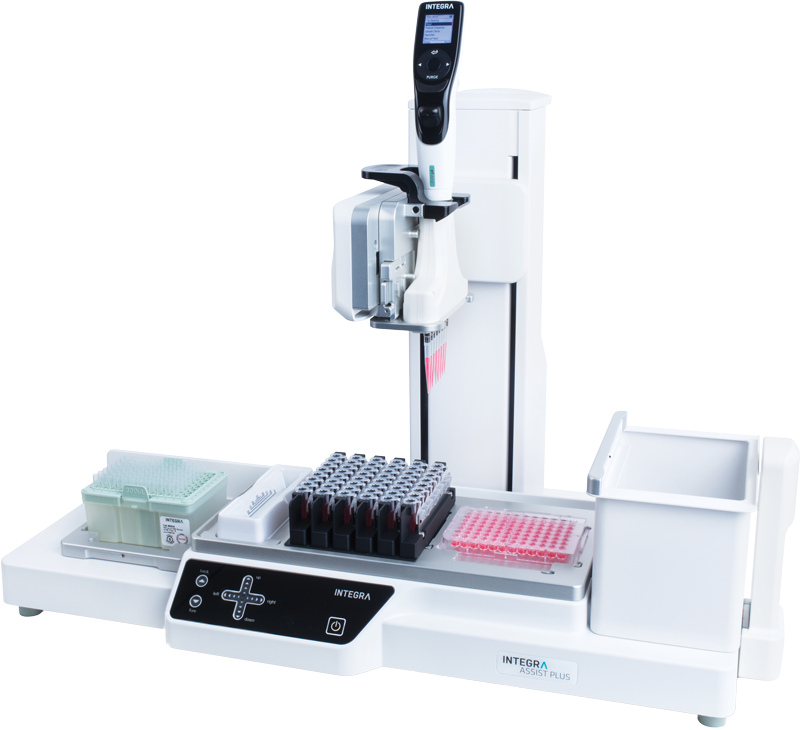
VOYAGER, 8 Channel, 125 µl
VOYAGER pipettes allow the tip spacing to expand anywhere between 4.5 mm and 33 mm at the push of a button.
- Single handed operation leaves the other hand free to handle labware.
- On the fly access to up to 3 user-defined tip spacings.
- These user defined tip spacings are saved. No need to memorize spacings of different labware formats.
Part No. 4722
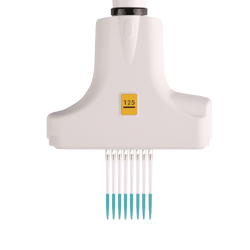
Dual Reservoir Adapter
The dual reservoir adapter makes this system ideal for assays that required sequential addition of several low volume reagent mixes. This adapter holds two 10 ml, 25 ml or divided reagent reservoirs side by side in an aluminum frame, and can be pre-chilled to keep reagents cool during processing.
Part No. 4547
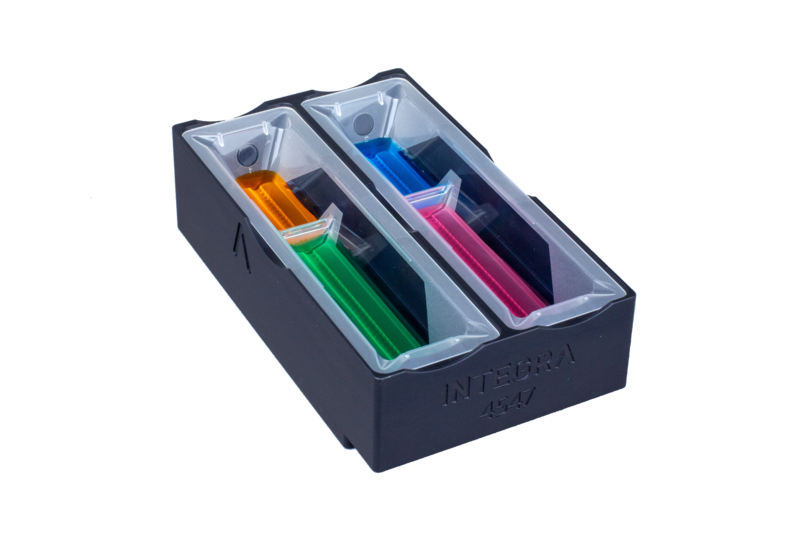
Divided Reagent Reservoir, Sterile, SureFlo anti-sealing array, 25 ml, PS
Lowest Dead Volume On The Market!
25 ml divided reservoirs are comprised of 5 and 10 ml compartments, while still nesting comfortably in the standard 25 ml reusable, sturdy base.
Each reservoir features the SureFlo™ anti-sealing array and hydrophilic surface treatment providing especially low dead volumes.
Part No. 4350, 4351, 4352
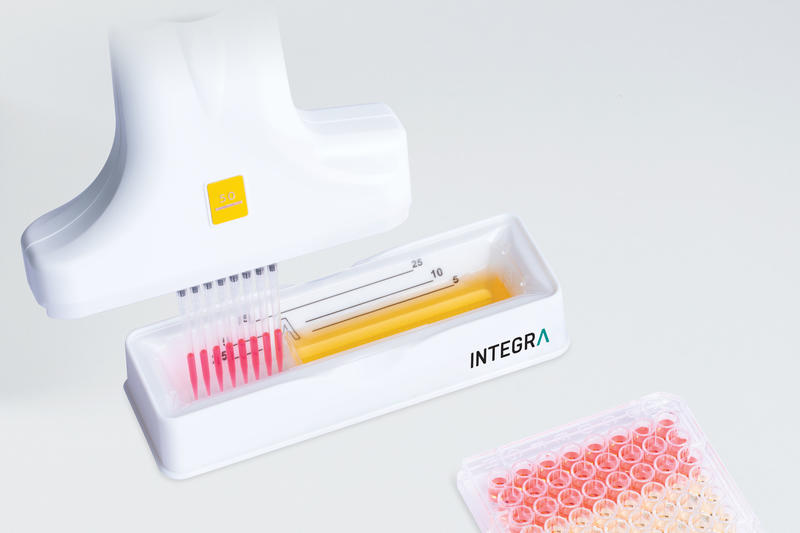
GRIPTIPS®, 125 µl, Sterile, Filter (for automation systems)
GRIPTIPS® pipette tips perfectly match the multi-lobe tip fitting, snapping firmly on during loading. This guarantees a perfect seal on every tip, preventing them from loosening, leaking or completely falling off. All tips are precisely aligned horizontally, enabling accurate touch-offs, even when pipetting with 384 tips.
Part No. 6465
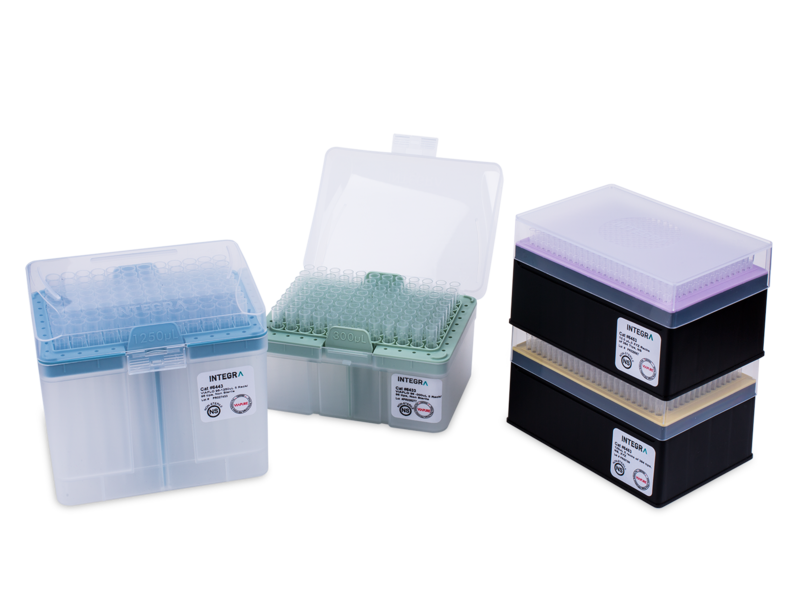
Greiner Bio-One: 96 Well Microplate, PS, F-Bottom
SAPPHIRE MICROPLATE, 96 WELL, PP, FOR RT PCR, WHITE, HALF-SKIRT, FOR LIGHT CYCLER, 10 PCS./BOX
Source: Website Greiner Bio One
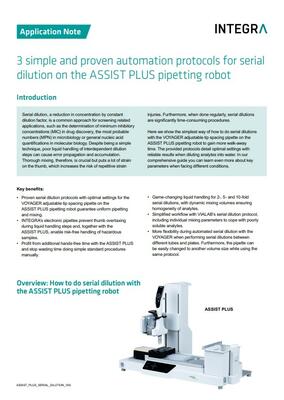
Download
Download App Note as PDF
Download3 simple and proven automation protocols for serial dilution on the ASSIST PLUS pipetting robotCustomer’s voice
The ASSIST PLUS is a friendly, easy to use, liquid handling system that helps us perform the routine lab work with ease and avoiding human errors.

